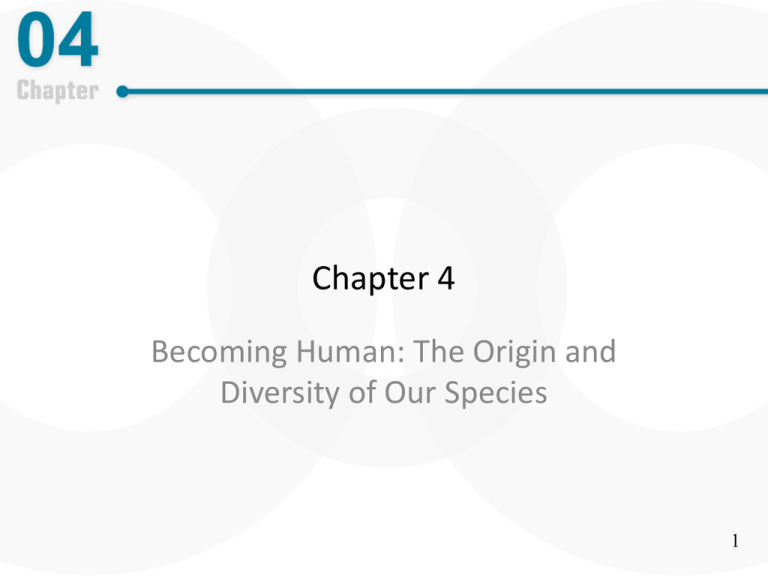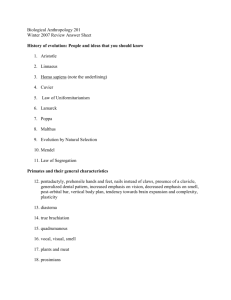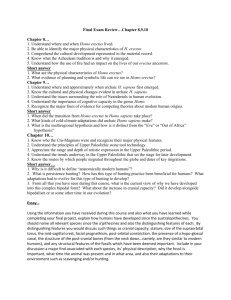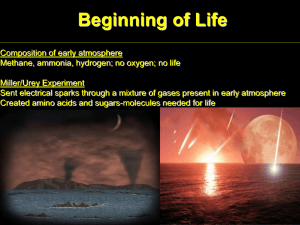Haviland_Cultural 04.ppt
advertisement

Chapter 4 Becoming Human: The Origin and Diversity of Our Species 1 What Will You Learn? • Describe the origins and molecular basis of evolutionary theory. • Identify the relationship between humans and other primates. • Compare the earliest bipeds to one another and also to chimps and humans. • Summarize the major biological and cultural features of human evolution. • Understand the controversy between humans and Neandertals. • Human variation and skin color. 2 Evolution through Adaptation • Evolution refers to change through time. Biologically it refers to changes in the genetic make-up of a population over generations. – Genes are the basic physical units of heredity that specify the biological traits and characteristics of each organism. 3 Evolution through Adaptation • Organisms evolve through a series of adaptations which might be selected for or against by nature. • Adaptations are the series of beneficial adjustments of organisms to their environment. • Natural Selection is the mechanism by which individuals having biological characteristics best suited to a particular environment survive and reproduce with greater frequency than individuals without those characteristics. 4 History of Research on Evolution and Genetics • Charles Darwin is most noted for coming up with the idea of Natural Selection, a theory he refined through his travels around the globe. • While he recognized that species had an ability to adapt to their environment he did not know how it occurred. 5 History of Research on Evolution and Genetics • Gregor Mendel is often referred to as the father of genetics. He provided the “how” of adaptation through his genetic work involving pea plants. • Today, having mapped the human genomethe genetic design of a species - with its complete set of DNA, we can learn that our species shares most of its DNA with one other living primate, the chimpanzee. 6 Humans and Other Primates • Humans are but 1 of the 10 million species on earth today. A species is a population having common attributes and the ability to interbreed and produce viable, fertile offspring. • The human species is one kind of primate or subgroup of mammals that also include, lemurs, lorises, tarsiers, monkeys, and apes. 7 Anatomical Adaptation • Both ancient and modern humans belong to the primate order. • Compared to other mammals, primates have only a few anatomical specializations while their behavior patterns are very diverse and flexible. 8 Primate Dentition • Primates have generalized teeth, which allow them to eat a variety of foods. • We each have incisors, canines, pre-molars and molars although the number and size may vary. 9 Primate Vision • Stereoscopic vision and binocular vision allow primates to see in 3-D and perceive depth. 10 Primate Brain and Skeleton • Increased brain size in the cerebral hemispheres are the areas supporting conscious thought. • Flexible limb structure allows primates to be agile. • There is greater reliance on vision over smell as we move up the primate taxonomy closer to humans. 11 Behavioral Adaptation • The study of primates, particularly apes, provides anthropologists with clues about the earliest development of the human cultural behavior. 12 Chimpanzees & Bonobos • Highly social primates - dwell in groups • Socially stratified by dominance (male and female dominance in groups) • Female bonobos form stronger bonds than common chimps • Both sexes may hunt other primates, may hunt in groups • Share meat to attract sexual partners • Sexual practice for pleasure 13 Chimpanzee and Bonobo Development • All social behaviors are learned • This may include: – Tool making, food provisioning, shelter construction, place in social hierarchy, language, communication, etc. 14 Human Ancestors • Humans are classified as hominoids - a broadshouldered group of primates that includes all living and extinct apes and humans. • Humans and their ancestors are known for their distinct locomotion of bipedalism or walking on two legs. 15 The First Bipeds • • • • 6 mya, Chad = Orrorin tugensis 4.4 mya, Ethiopia = Ardipithecus ramidus 3 mya, Ethiopia = Australopithecine afarensis Australopithecines; genus including several species of early bipeds from southern, eastern, and central Africa (Chad) living between 1.1 and 4.3 mya, one of whom was directly ancestral to humans. 16 Early Homo • Meat consumption is necessary for survival on the savannah. Much like living apes, ancient hominids would have solved their need for meat in a similar way. • Tool production would have allowed for early hominids to be more effective scavengers of meat. 17 Lower Paleolithic • The appearance of stone tools and choppers marks the beginning of the lower paleolithic or the first part of the Old Stone Age, spanning from 200,000-250,000 years ago. • Oldowan tool tradition is the name given to the first and oldest stone tools between 2.52.6 mya. 18 Early Homo • Homo habilis - “Handy Man” first fossil member of the genus Homo appears 2.5 mya, with larger brains and smaller faces than australopithecines. 19 Homo erectus Fossil Sites 20 Homo erectus • Shortly after 2 mya, at a time when Homo habilis and Oldowan tools had become widespread in Africa, Homo erectus emerged. • Homo erectus - “Upright man.” A species within the genus Homo first appearing after Homo habilis, ultimately spreading throughout the Old World. 21 Homo erectus • • • • • • Narikotome Boy 1.6 mya Lake Turkana, Kenya 5 feet 3 inches tall 13 years old 60% complete fossil skeleton 22 Critical Thought • Often paleoanthropologists do not uncover whole fossil skeletons. They may only find: – Jaw, teeth, femur or tibia (leg bones), partial skull, etc. • Given the above skeletal elements, what unique things can we still learn about the lifestyle, diet, environment, or capabilities of these hominids? 23 Fire Making in Early Human Development • Remains found in southern Africa suggest H. erectus may have learned to use fire by 1 mya. • Without controlled fire it is unlikely early humans could have survived dropping temperatures or moved into colder regions with no protection. • Fire also allows for cooked foods and wider diet. 24 Beginnings of Homo Sapiens • Within paleolithic sites in Africa, Asia, and Europe, a large number of human fossils have been found that date between roughly 200,000 and 1 mya. • In Atapuerca, Spain, 6 individuals were excavated, dating to 800,000 years ago. – Homo antecessor? Homo heidelbergensis? 25 The Neandertal Debate • Neandertals are a distinct group within the genus Homo inhabiting Europe and Southwest Asia from 30,000 -125,000 years ago. • Largest area of debate is the genetic relationship among humans and Neandertals. – Were they a separate species going extinct 30,000 years ago? Or were they an archaic subspecies of Homo sapiens? If so did they contribute to our modern day genome? 26 Neandertal Tools • Mousterian tool tradition is the tool industry associated with Neandertals in Europe and Southwest Asia, and their human contemporaries in northern Africa, during the Middle Paleolithic, generally dating from about 40,000 to 125,000 years ago. 27 Human Evolutionary History 28 Anatomically Modern Peoples and the Upper Paleolithic • A veritable explosion of tool types and other forms of cultural expression beginning at about 40,000 years ago constitutes the Upper Paleolithic. • Last part of the Old Stone Age (10,000-40,000 years ago), featuring tool industries characterized by long slim blades and an explosion of creative symbolic forms. 29 Tools of the Upper Paleolithic 30 Tools of the Upper Paleolithic • Tools of the Upper Paleolithic became smaller and projectile. Also during this time, art, carvings, and ornaments appear. • The spear thrower or atlatl was invented about 15,000 years ago as a way to increase distance and maintain accuracy. 31 Tools of the Upper Paleolithic 32 Chauvet Cave Paintings • 31,000 years old • Paintings consist of many animals such as bear, horses, wild ox, rhino, and bison. 33 Hypotheses on the Origins of Modern Humans • Multiregional hypothesis - states that the fossil evidence suggests a simultaneous local transition from H. erectus to modern H. sapiens throughout the parts of the world inhabited by early members of the genus Homo. 34 Hypotheses on the Origins of Modern Humans • Africa origins hypothesis (Eve,or out of Africa hypothesis)- uses genetic and other evidence to argue that all anatomically modern humans living today descend directly from one single population of archaic H. sapiens in Africa. 35 Human Biological Variation and the Problem of Race • In biology, race is a subgroup within a species, not scientifically applicable to humans because there exist no subspecies within modern Homo sapiens. 36 Race as a Social Construct • Throughout time various naturalists and scholars have attempted to classify and identify “races.” • Race has been classified by skin color, geographical location, ethnicity, intellectual abilities, etc. 37 A Pygmy Man in the Bronx Zoo • Captured during a raid at 23 years old and 4’11’’ Ota Benga, a Mbuti Pygmy, was placed into a primate exhibit as though he were an animal. • Once released later in his life he committed suicide upon learning he would never be returned home. 38 Race as a Biological Construct • Often social constructions of race are falsely tied to the idea that there is a biological foundation to the concept of human race. 1. Race is arbitrary, there is no agreement on how many differences it takes to make a race. 2. The biological definition of race is that it does not mean that any one so-called race has exclusive possession of any particular variant or any gene(s). 3. There are greater differences among individuals within a particular population than the differences among populations. 39 Skin Color: A Case Study in Adaptation • Skin color is genetically coded for by our melanin - the amount of skin pigmentation found in the outer layer of skin. • Melanin is a natural block against the suns harmful UV rays. • More melanin can help protect equatorial populations from over exposure of sun. These populations also tend to have darker skin. 40 Skin Color: A Case Study in Adaptation • Alternatively individuals living closer to the poles tend to have lighter skin (less melanin). • This allows for more absorption of UV rays which can stimulate Vitamin D production, a necessary building block for a healthy skeleton. 41


